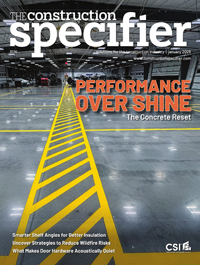Controlling moisture balance with watertight vapor-open assemblies
Controlling vapor diffusion
Assemblies do not always require vapor barriers. Historically, they dried both outward and inward, could manage leaky windows without flashing, and could be rained on during construction. The key to this superior moisture management in older buildings was poorly insulated or uninsulated walls. The heat that flowed through helped dry the assembly of any moisture.
A trend toward tighter and more highly insulated enclosures led to higher levels of interior moisture. This, coupled with continuous exterior insulation, which resists the flow of heat through the assembly, reduces the wall’s drying potential. Therefore, interior moisture should be handled at the source using ventilation fans, and through the proper design, installation, and operation of the building’s heating and cooling system. The interior moisture that cannot be eliminated needs to be controlled by an air and vapor barrier.
Controlling the flow of air is more important than controlling vapor diffusion. During a heating season, air leakage through gypsum board with a hole in the middle will result in 28.4 L (7.5 gal) of water. However, vapor diffusion through a solid sheet of gypsum board with no hole will only result in 0.3 L (0.08 gal) of water.
Vapor-open assemblies
Although vapor barriers (where required) are intended to prevent assemblies from getting wet, they also often prevent them from drying. Vapor barriers installed on the interior side of assemblies impede drying toward the interior (e.g. vinyl wallpaper, white boards, etc.)—this is a problem for air-conditioned spaces and can be an issue when there is also a vapor-impermeable material on the assembly’s exterior, creating a double-vapor-barrier wall assembly (i.e. impermeable continuous exterior insulations such as polyisocyanurate or extruded polystyrene boards). Therefore, it is practical to encourage drying mechanisms over wetting prevention mechanisms—meaning one should avoid using vapor barriers if vapor retarders will work and avoid using vapor retarders when vapor-permeable materials suffice. Additionally, some flow-through assemblies need a ventilated cladding system to cover the continuous insulation (ci) or exterior sheathing to let the passing moisture get around the wall assembly. Most claddings do not need a significant amount of space. Dr. Joe Lstiburek recommends a minimum of 9.5 mm (0.38 in.).
However, when it comes to reservoir claddings, such as brick veneers, and very vapor-open sheathings (coupled with very vapor-open water and air control layers), a building will require larger space for ventilation to handle higher moisture loads. For stucco or adhered stone over a wood-based sheathing, the 2021 IBC (Section 2510.6.2, Moist or marine climates) requires a minimum space of 4.8 mm (0.19 in.) to the exterior of a Grade D 60-minute equivalent water-resistive barrier. The 2021 International Residential Code (IRC) uses the same language.
The inward motion (known as solar-driven moisture) occurs with a rain-wetted reservoir cladding, coupled with solar radiation and air conditioning. This inward motion should be “throttled” down and the cladding should be uncoupled with a ventilated air space, or the size of the reservoir might need to be reduced by painting the cladding or by using additives with the ability to reduce water absorption.






